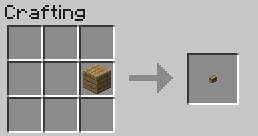Minecraft: Redstone, transportation - recipes, list, crafting
In this chapter of the Guide to Minecraft, you will find a selection of recipes for creating logic and automatic circuits, using signals generated by pressure plates, levers, etc., but also more complex elements like a light sensor. In the following chapters of the Guide, you will also find interesting ideas for using them and creating complex and useful mechanisms.
In addition, you will find information about transport: boats, construction of tracks and mining carts are not the only vehicles. And, of course, not the only use for them...
- Button
- Pressure Plate
- Leveler
- Redstone Torch
- Redstone lamp
- Tripwire Hook
- Trapped Chest
- Daylight Sensor
- Dispenser
- Dropper
- Repeater
- Comparator
- Piston
- Sticky Piston
- Hopper
- Powered Rail
- Activator Rail
- Minecart with hopper
- Detection Rail
- Rails
- Minecart
- Minecart with Furnace
- Minecart with TNT
- Minecart with Chest
- Boat
Button

Pressing it results in sending out the redstone signal. Can also be built of stone.
Pressure Plate

Pressing it results in sending out the redstone signal. Can also be built of stone.
Leveler

The leveler can be switched on and off to activate/deactivate redstone signal.
Redstone Torch

A source of redstone energy and logic elements. Provides little light. In the appropriate circuit can be used as a diode.
Redstone lamp

The Redstone Lamp is activated with the redstone signal. Does not conduct the redstone signal.
Tripwire Hook

The Tripwire hooks activate traps after the tripwire between them is broken. The thread must be based for the trap to work; will be lost after the trap is activated. It's also a crafting element used to create a trap chest and a crossbow.
Trapped Chest

The Trapped Chest sends out redstone signal, once it is opened.
Daylight Sensor

The Daylight Sensor sends out the redstone signal, whenever it receives sunlight. Requires wood panels, blocks of glass and quartz to create.
Dispenser

An object which is most commonly used as a component of traps. After it receives the redstone signal, it throws out the items contained in it (one by one). It additionally endows fireballs and arrows with speed, thereby inflicting damage to the objects in front of the dispenser. In addition, dispenser finds application in the automation of the database. Compared to a tray, it can't transfer an object to a chest. Additional practical applications:
- Fills glass bottles with water and buckets when water/lava tank is in front,
- Cuts sheep's wool when there are shears inside,
- If there are tracks in front of the dispenser, you can put a cart on them,
- It can set on fire when you have a lighter,
- Uses bone meal to feed the plants in front of him,
Can throw eggs to break them and possibly bring out chickens.
Dropper

Works as a principle similar to the dispenser, but it disallows using the items inside. It only makes the objects fall out (one by one). Its main purpose is to move items to another container that stands right in front.
Repeater

Amplifies the redstone signal thanks to which it is transmitted over longer distances.
Comparator

This device allows you to compare individual redstone signals. Most commonly used as a "weight" - a larger number of items on a pressure plate than on another generates a more powerful signal that the comparator compares and generates or not a redstone signal. You can compare contents of containers (chests, ovens, feeders, etc.).
The strength of the signal also depends on the distance - make sure that the distance of the two compared objects from the comparator is the same!
Piston

The Piston moves the block in front of it whenever it receives the redstone signal. Finds application in construction, for example, hidden transitions and automation. Most of the objects built by you are pushed, but destroyed.
Sticky Piston

The Sticky Piston works just like the regular one, with the difference that it moves a block attached to it.
Hopper

Allows for removing and inserting items into the objects (eg. chests) in which they are contained. The object thrown directly on the bunker is sucked in. This way you can automate processes and put objects into the hopper using trays, water, etc.
Powered Rail

The connected redstone signal sources lend speed to the minecarts running over them. You need to place them sporadically, interspersed with the regular rails. The object thrown directly on the bunker is sucked in. This way you can automate processes and put objects into the hopper using trays, water, etc.
Activator Rail

They find application for objects placed in wagons, such as TNT or Hopper. They're sending signals to redstone under the traction. Finds application in transport automation.
Minecart with hopper

Minecart with hopper. Load items automatically, then move to any place.
Detection Rail

After the minecart runs over it, redstone signal is sent to the circuit. This can lead to a specific action when the car passes through this field. Great for organizing traffic in the presence of a complex network, rails and trolleys.
Rails

Regular rails over which the minecart can move.
Minecart

Used to move along rails. It can be adapted for various functions. Sit in it to move it or build power rails to make it drive itself (or let it go down the hill). Cars can be connected. Mobs can ride the cars, so some monsters can be transported to/from places.
Minecart with Furnace

A Minecart with the characteristics of a regular one, with furnace on it. Note - the furnace is not used for burning objects, but as a drive for the locomotive.
Minecart with TNT

Minecart with a TNT charge mounted onto it. It can be activated by rolling over the Activator Rails.
Minecart with Chest

The chest placed in the minecart allows you to transport resources over the rails.
to automatically pull the items from this box, mount a hopper under rails.
Boat

Used to move on water. After it is destroyed, it breaks up into the components that it was crafted off.
- Minecraft Guide
- Minecraft: Game Guide
- Minecraft: Crafting
- Minecraft: Recipes
- Minecraft: Food - recipes, list, crafting
- Minecraft: Redstone, transportation - recipes, list, crafting
- Minecraft: Weapon, armor, tools - recipes, list, crafting
- Minecraft: Decorative elements - recipes, list, crafting
- Minecraft: Construction elements, equipment - recipes, list, crafting
- Minecraft: Encyclopedia - what is it? Crafting guide
- Minecraft: Miscellaneous - recipes, list, crafting
- Minecraft: Dyes - how to create? Recipes, list, crafting, tips
- Minecraft: Recipes
- Minecraft: Crafting
- Minecraft: Game Guide
You are not permitted to copy any image, text or info from this page. This site is not associated with and/or endorsed by the developers and the publishers. All logos and images are copyrighted by their respective owners.
Copyright © 2000 - 2025 Webedia Polska SA for gamepressure.com, unofficial game guides, walkthroughs, secrets, game tips, maps & strategies for top games.
